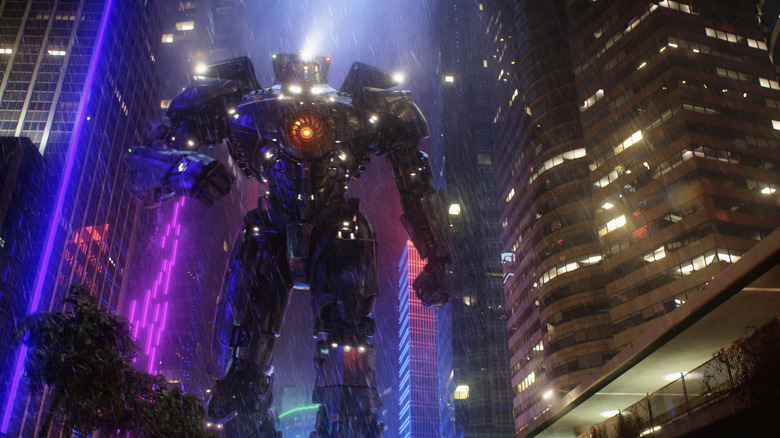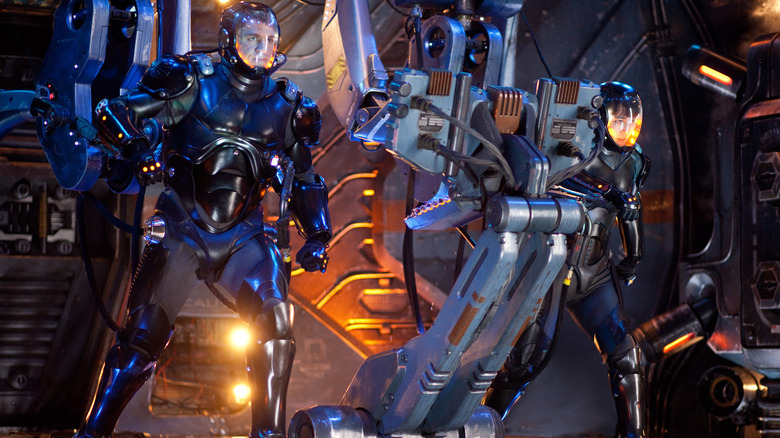Pacific Rim Required Guillermo Del Toro To Rewrite His Rules For Filmmaking
How many directors can claim to have helmed one of the more entertaining, gleefully lowbrow blockbusters in recent memory (about giant robots fighting kaiju, of all things) before going on to win Best Picture for a very different kind of movie a few years later (about a woman who falls in love with a fish-man, of all things) ... all while both films managed to maintain all of that filmmaker's unique sensibilities? Off the top of my head, I can't imagine such a list is all that long, so naturally, Guillermo del Toro was able to step up to the plate and pull off this feat in style. There's no Oscar category for "Best Popular Blockbuster" just yet (despite the Academy's best efforts this past year, at least), but there's certainly room for recognition for what del Toro accomplished with 2013's "Pacific Rim."
While the blockbuster experienced a rather mixed reception upon release and remains relatively divisive to this day (although I'd argue it deserves newfound appreciation, particularly in light of its misguided and noticeably del Toro-less sequel), there's very little arguing with the technical merits of the film. The nighttime action set pieces, framed by neon city lights and the bioluminescence of the kaiju themselves, were spectacular to behold on the big screen. The sense of grandeur and awe and scale that del Toro brought out through the VFX work remains awe-inspiring, even on much smaller screens at home. Also, one of the main lead protagonists is named "Stacker Pentecost" and Ron Perlman (playing a character called "Hannibal Chau") gets eaten by a baby kaiju before emerging alive and well in the post-credits stinger. It's brilliant.
But more importantly, "Pacific Rim" is perhaps most interesting for posing a unique challenge to del Toro's usual mode of filmmaking.
'The first person to change was me'
As mentioned, Guillermo del Toro has gone on to achieve Oscar immortality with the beautifully told "The Shape of Water," but "Pacific Rim" still provides quite a few insights into the director's filmmaking approach that have surely factored into his directing efforts in the time since. In a deep dive with Variety at the time, del Toro opened up about the radically different process that a production on the scale of "Pacific Rim" required of him. As he put it,
"I made a life decision that this movie needed to be huge in scope but run very, very tight on the production and the first person to change was me."
According to the report, those changes involved a much more compressed shooting schedule than del Toro was previously used to (down to 103 days, which he'd never done to that point) and the need for the habitually hands-on director to put even more time into the production. That apparently meant workdays of up to 18 hours a day and a grueling, nonstop 7-day workweek.
But those adjustments went even further than that. As it turns out, the filmmaker also needed a new methodology for directing actors, as well.
"If you watch 'Pan's Labyrinth' or 'The Devil's Backbone,' I had an obsession that was really, really all-consuming with making the actors move in an extremely mannered way that matched the camera moves. In those movies I wanted it to be balletic, but I also wanted it to be almost like a ritual or a dance. But on 'Pacific Rim' I needed to allow the actors to breathe a lot more. I wanted to shoot a lot looser and even allow for improvisation, which I had never done."
The mark of a great director has to be the willingness to adapt to new situations and circumstances ... but don't let that fool you into thinking that "Pacific Rim" is any less of a personal vision than del Toro's other movies. To put a button on it, he explained, "Everything, 100% goes through me sooner or later. I do not delegate anything. Some people like it, some people don't, but it has to be done that way."
That right there proves yet another shared quality between movies as wildly different as "Pacific Rim" and "The Shape of Water."

